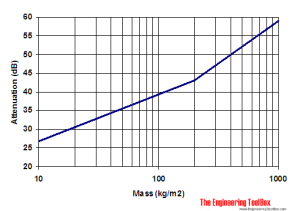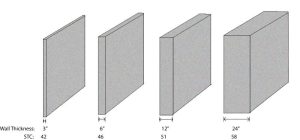Mass Law – What is It?
The mass law, also known as the mass-air-mass law. Is an acoustics principle that defines the relationship between a partition’s mass. As well as its ability to block or attenuate sound transmission. According to the mass law, the sound transmission loss (STL) through a partition is directly proportional to the partition’s mass per unit area.
Simply put, the mass law states that increasing the mass of a barrier or partition, such as a wall or a barrier, increases its ability to reduce sound transmission. This is because the mass functions as a barrier, preventing sound waves from passing through the partition.
Mass Law.
The mass law is derived from sound transmission’s fundamental mechanics. When a sound wave encounters a partition, it may be partially absorbed, partially reflected, or partially transmitted through the partition. The transmission loss is the decrease in sound energy that occurs when a sound wave travels through a partition. The greater the transmission loss, the more effective the acoustic performance of the partition.
The graph below how’s how increasing the mass increases the attenuation by approximately 6dB per doubling.
According to the mass law, a partition’s transmission loss increases by approximately 6 decibels (dB) (usually 5dB in practice). When its mass per unit area is doubled, this indicates that increasing the bulk of a partition by a factor of 10. Will always result in an enhancement of approximately 20 dB in transmission loss.
Mass Law Effect.
The image below shows the increased acoustic performance of doubling the thickness of a concrete wall. Hence doubling the mass.
Notably, the mass law implies that other variables, such as rigidity and damping, remain constant. In reality, additional factors affect the transmission loss of a partition. These include the rigidity and damping properties of the materials used, the thickness of the partition, and the frequency of the sound being transmitted. These factors can affect the overall sound insulation performance of a partition and may need to be considered in conjunction with its mass.
The mass law is a fundamental principle in the world of acoustics. For comprehending the function of mass in sound insulation and designing effective soundproofing measures. It is possible to increase sound insulation and acoustic privacy in residential buildings, offices, and recording studios by increasing the bulk of partitions.
If you would like to learn more. Please contact a member of the CSG Acoustics team and we will be happy to assist you.
Why not sign up to the rest of our blog series. There are 33 in total – and by signing up in the following link you will be notified each week when a new blog is released – https://mailchi.mp/csgacoustics/blog-engagement
Visit the previous blog on Flanking Sound here: https://www.csgacoustics.co.uk/flanking-sound-what-is-it-and-how-can-we-help-reduce-it/
Stay tuned for next week’s blog Point Source!





